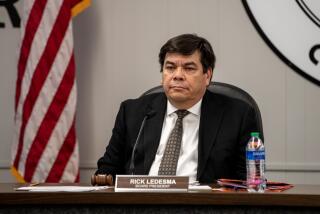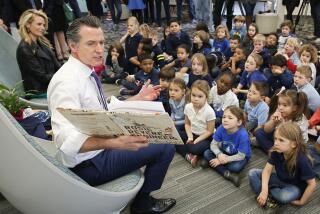Overlooking the Obvious Problems in Education
The point of our back-to-school night was to help parents become familiar with our Expected Schoolwide Learning Results, affectionately known as ESLRs, our fivefold path to achieving the state-mandated curriculum standards. Much of the presidential campaign revolved around improving education, and administrators and teachers nationwide are under the gun to prove that schools can deliver.
Faced with growing numbers of students who enter high school reading at or below sixth-grade level, we have our work cut out for us--particularly as the specter of rigorous statewide high school exit exams looms. Many educators believe that the first steps in this campaign to improve student achievement are the development and implementation of articulated school-wide standards.
The goals set forth in our ESLRs are laudable, and they have become our mantra. In districts throughout the state, ESLRs are printed in student handbooks, on classroom posters and, at our school, on T-shirts that all staff members were politely asked to wear during back-to-school commencement activities held in the gym. Most of my conscientious, hard-working, incredibly dedicated colleagues did.
*
We sat huddled together in the bleachers--the team, suited up in our ESLR shirts, determined to turn the tide on falling test scores and poor student achievement. And while we sat there watching performances by the marching band, the cheerleaders and the dance team, a student who had been assigned to videotape the proceedings paraded about the facility in full view of parents, the faculty and district officials sporting a T-shirt with the words “Up Yours” boldly printed on the back.
No one that I know of demanded that he change his shirt. Certainly I didn’t; I just sat there dumbfounded. Maybe most people didn’t notice, or maybe they chose not to. Sometimes, the obvious is just too painful to confront. It seems to me that in the fervor concerning standards and accountability, the obvious often is overlooked.
The obvious was clearly pointed out to me in an exercise in which I require students to teach a short story to their peers. To design a lesson for their fellow classmates, I asked students to write down how they learn best and to recall a favorite lesson. Then I asked them to share their responses. Two recurring themes surfaced. One was the need for quiet time and the other was the opportunity to receive one-on-one instruction from a competent and caring teacher.
*
Nationwide, many of high schools are overcrowded. Oxnard High School, with 3,100 students and with more than 38 students per class, is by no means unusual. Under such conditions, how often do students find quiet time or receive one-on-one instruction? Not often enough. And the result of this deficiency is all too apparent. Too many students have little or no affinity for their school. When I’ve asked them to account for this lack of school spirit, they reply, “I feel like I’m a number, just another face in the crowd.”
We can and should be held accountable to high standards. We should have a school-wide plan to ensure that all students achieve their highest potential. But until we address the obvious--class-size reduction and the recruitment and retention of competent teachers--an “up-yours” reign of cynicism will fester among students who feel increasingly disconnected from their school.
More to Read
Sign up for Essential California
The most important California stories and recommendations in your inbox every morning.
You may occasionally receive promotional content from the Los Angeles Times.










